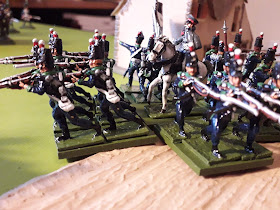We left the action with the French having the upper hand. The British had lost their Cavalry, one battalion of infantry and the rifles. No French unit had been reduced in strength enough to put it out if action.
Charge has very simple morale rules. Once an Infantry unit is reduced to below 50% it is no longer effective and retires 2 moves and may make no offensive action and fights with severely reduced capabilities. A light or cavalry unit must be reduced to less than a 1/3.
Anyway back to the action. Wellington turns to Mack and mutters "Give me Blucher or get me a fast horse".
He rolls a D6 needing a 2 or less for Blucher to arrive. After a few minutes of muffling disparaging comments about Prussian time keeping he rolls the dice - a glorious 2.
Blucher leads the Prussian 9th RIR into the field.
And next turn the Lutzow Uhlans and Austro-Portuguese Legion arrive.
With the arrival of the Prussians Picton leads forward the 23rd Foot. Overrunning a French Artillery battery before driving off the already weakened 10th Legere. The Polish battalion and 23rd exchange close range fire with sees both units reduced to 50% and effectively out of the game.
With the centre lost the French decide to push their attack with the 2 battalions on their right.
With flags flying the French advance towards the hill where all they can see is a RHA battery which looses of a few rounds before retiring.
As the French crest the hill they are hit by a close range volley from a fresh battalion of Nassuers concealed on the reverse slope.
A quiver of shock goes through the French ranks however with exhortations of Vive L' Empereur the French close with the Nassuaers who are able to get off another close range volley which lays low even more French. The melee is short and sweet. The French lose the melee and with both battalions below 50% they are forced to retire.
With the day drawing to a close there is a final act. The Prussian infantry is forced into square by the presence of the French Carabiniers and Hussars. Blucher is forced to shelter the 9th RIR square.
He gives orders to his ADC 'I am a proud soldier and I don't win battles by hiding in squares. .Tell Lutzow to drive off those French cavalry'
The 2 squadrons of the Lutzow Lancers charge the French Carabinier and Hussars. After the first round of melee they lose 2 figures and inflict no casualties on there opponents.
Lutzow rolls D6, needing a 4 or more, to see if the melee ends or if there is a second round. A 6 is throw.
With gritted teeth Lutzow brings up his second squadron and extends the line. He drives his men forward and joins the fray.
The melee goes better for the Prussians and with Lutzow fighting the last melee he needs to win to draw the melee overall. In Charge Cavalry melees are resolved by figure to figure comvats resolved by opposed dice rolls.
The French Hussar rolls a 4. Lutzow rolls a 6 laying the unfortunate Hussar low. The 2nd round ends with a total score of 3 loses each over the 2 rounds. Each side must retire 2 moves to recover.
With the cavalry melee decided the French concede defeat. Ney will have a hard time explaining this to the Emperor.
Overall the Charge rules worked well. The game moved at a cracking pace and I rather liked not having to worry about complex morale rules and testing for umpteen different reasons to see if a unit had good morale. Indeed the good old 50% worked well and was quit liberating.
I will write more in my next post on my Charge Napoleonic rule amendments.
Out of interest does anyone have copy of the this Athena version of the Charge rules. I understand that they included extra Napoleonic rules.
If you do and a willing to copy the Napoleonics please drop me an email.























































